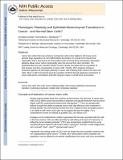Phenotypic plasticity and epithelial-mesenchymal transitions in cancer and normal stem cells?
Author(s)
Scheel, Christina; Weinberg, Robert A
Downloadnihms341952.pdf (232.8Kb)
OPEN_ACCESS_POLICY
Open Access Policy
Creative Commons Attribution-Noncommercial-Share Alike
Terms of use
Metadata
Show full item recordAbstract
Cancer stem cells (CSCs) are similar to normal stem cells in their ability to self-renew and to generate large populations of more differentiated descendants. In contrast to the hierarchical organization that is presumed to be the prevalent mode of normal tissue homeostasis, phenotypic plasticity allows cancer cells to dynamically enter into and exit from stem-cell states. The epithelial-mesenchymal transition (EMT) has been closely associated with the acquisition of both invasive and stem-cell properties in cancer cells. Thereby, EMT programs emerge as important regulators of phenotypic plasticity in cancer cells including their entrance into stem-cell states. Much is still to be learned about the regulation of EMTs through epigenetic mechanisms in cancer cells and the contributions that EMT programs make to normal tissue homeostasis.
Date issued
2011-07Department
Massachusetts Institute of Technology. Department of Biology; Ludwig Center for Molecular Oncology (Massachusetts Institute of Technology)Journal
International Journal of Cancer
Publisher
Wiley Blackwell
Citation
Scheel, Christina, and Robert A. Weinberg. “Phenotypic Plasticity and Epithelial-Mesenchymal Transitions in Cancer and Normal Stem Cells?” International Journal of Cancer 129, no. 10 (August 29, 2011): 2310–2314 © 2011 UICC
Version: Author's final manuscript
ISSN
0020-7136
1097-0215